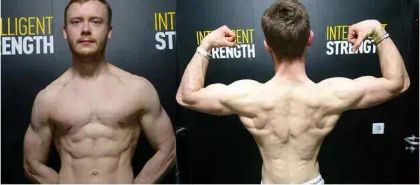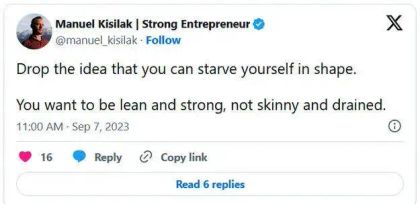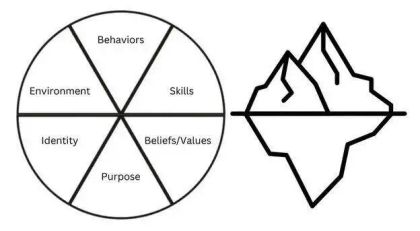If you’re like most entrepreneurs, you have clear goals and want to act immediately.
SMART goals are great for that:
They give you clarity and enable quick action.
And as Arnold Schwarzenegger said:
Without knowing where you’re going, you’ll never end up anywhere.
But here’s the problem:
Knowing your goal and what to do to get it is only the tip of the iceberg.
Let's take losing weight as an example:
The information on how to do that is EVERYWHERE.
Still, 70% of US Americans are overweight.
If you’re…
- Clear about your goals
- Aware of what you need to do
- Someone who tends to execute fast
… but still not getting closer to your goal, you’re missing something crucial.
Read on to learn deep goal-setting to achieve peak fitness and energy to thrive in your business.
Nothing is free
In his book Essentialism, Greg McKeon writes about the reality of trade-offs:
Every goal comes at a cost.
And the question is, is what you want worth the price?
Let’s take getting shredded as an example, which is portrayed as the ideal on social media:
You might think it would be amazing to have six-pack abs and be super lean all year round.
But to get that lean, you’ll have to skip family meals at restaurants because you'll be counting calories closely.
You’ll also find that your energy drops, making running your business harder.
I learned this first-hand in 2018 during the aggressive diet I did for my strength coach education:

This was the leanest I’ve ever been, but the costs were severe:
- I was irritable and moody all the time
- I could barely get out of bed in the morning
- I struggled to focus for more than 15 minutes
I couldn’t afford these costs long-term as an entrepreneur, which is why I follow a different philosophy:
Optimize for strength and energy, while still looking great - without the hassle of tracking every nutrient like a mad scientist (HERE to learn more about it).
Here’s the reality:
Without addressing trade-offs, you'll feel like you're putting in effort but getting nowhere.
You might even call it “self-sabotage”.

Let’s take it a step further…
The benefit of failure
Here’s something most people miss:
True goal-setting also involves recognizing the value in NOT changing.
The book "How to Win Friends and Influence People" contains a great story that illustrates this:
A woman wouldn't leave her bed because it was the only way she knew to get her husband's attention.
Despite her health suffering, she valued his attention more.
This is an extreme example, but the core idea applies to fitness or business goals.
Some benefits of not making change might be:
- Keeping your current eating habits
- Not having to make time for the gym
- Avoiding criticism from people around you
- Being able to “relax” on the couch after work
- Not facing the stress or fear of trying something new
- Avoiding the initial soreness or fatigue from new workouts
Consider the 6 logical levels (I wrote about them in-depth HERE):

You have to align them with your goals.
Here are some questions that will help you uncover hidden benefits of not making progress:
- What would be the consequences of reaching that goal?
- How would it affect the people around you?
- Is there anything you wouldn't be able to do anymore if you reached that goal?
- How would it affect your vision?
- What is "good" about your current circumstance?
- Is there anything about the “good” that you would have to give up?
- Can (and if so how) you live with the consequences?
- If not, how could you adjust your goals?
- What’s your next step going to be?
We will use these answers to incorporate them into your goal-setting process:
1) Define your goal:
The SMART framework is great to do that.
Write down what specifically you want.
Make it:
- Specific
- Measurable
- Action-oriented
- Realistic
- Timebound
Here are some questions that will help you write this out:
- How do you want to look?
- How much weight do you want to lose?
- Why is this important for you?
- By what time will you reach this goal?
- What can you do that has the biggest impact to accomplish this goal?
- What will reaching this goal change for you?
- How are you going to feel?
But don’t stop here - let’s go deeper.
2) Get clear on the trade-offs:
First, the trade-off of achieving that goal.
Use the questions mentioned above.
But then also get clear on the trade-offs of not achieving that goal.
You might question if the three hours spent on fitness each week could be better invested in your business.
But at the same time…
You're out of shape.
Your energy levels are getting lower.
You don’t feel well in your body anymore and feel discouraged when you look into the mirror.
Where is this trajectory taking you over the next five years?
How does it affect your business, your health, and your family?
Take all of that into account.
3) Evaluate whether it’s worth it
At this point, you know the trade-offs of reaching your goal, as well as not reaching your goal.
Write down all the benefits in one column and all the costs in a column next to it.
Then, evaluate which one’s bigger.
Don’t do that in your head, write it out – this is important to realize that the cost is likely much higher than the benefit.
If the cost of staying the same is higher than the cost of change, you will change.
4) Make a clear decision
When I started training at age 16, I made an important decision:
I will do what I can to be strong.
This deep decision made it simple for me to go to the gym and stick to my plan:
I simply gave myself no alternative.
Here’s some harsh truth:
Being indecisive drains your mental energy more than making a decision, following through and correcting the course if necessary.
If you’re still in doubt after going through this process, go with the decision that leads you towards growth.
This won’t be comfortable, but if you’re the type of person who wants to make things happen, indecisiveness will hurt you more.
5) Act and iterate
Here’s another harsh truth:
All the mental work in the world cannot replace action.
You can journal all you want about how getting in shape would benefit your life - you still have to lift the weights.
Clarity comes through action - take your first steps and iterate along the way.
I’ve changed my philosophy towards fitness several times:
At first, all I wanted were six-pack abs.
But after I got them, I realized I was still weak and struggled with back pain.
Then, I shifted towards going all-in on strength.
After years of struggle, I finally figured out the principles of effective training - which peaked into me lifting triple bodyweight.
Later on, I noticed that being jacked and able to lift heavy wasn’t enough to support my pursuits in business.
That’s when I shifted towards optimizing for a holistic, high-performance lifestyle.
And I’m sure that I’ll change my approach in the future.
The bottom line is this:
You’ll never truly know unless you start and take action.
Summary:
Reaching your goals has trade-offs.
If you don’t consider them, you’ll start to self-sabotage.
SMART goals are a surface-level approach - you have to get deeper.
Use the Deep Goal Setting Process:
- Use the SMART framework to define what you want.
- Get clear on the trade-offs for achieving and not achieving that goal.
- Use the cost-benefit analysis to evaluate whether it’s worth it.
- Make a clear decision and stop wasting mental energy.
- Act and iterate along the way.
If you want to learn more about how to get in your best shape ever within two hours per week, click the link and hop on a free 1:1 strategy call with me.
